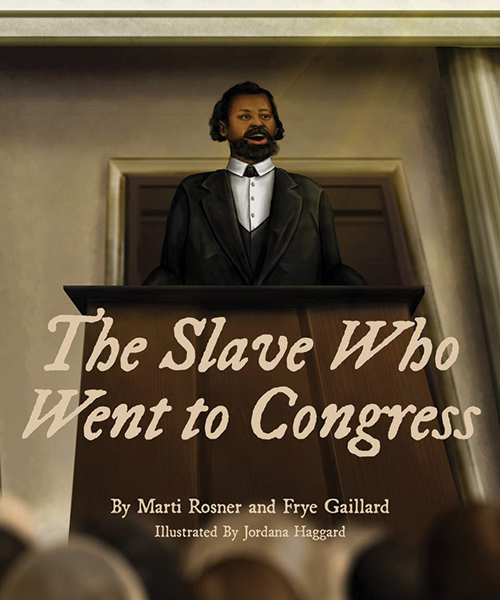
The Slave Who Went to Congress
Reviewed by Jerry Mizell Williams
December 1, 2020
By Marti Rosner and Frye Gaillard, illustrated by Jordana Haggard. NewSouth Books, 2020. 32 pages. $18.95/hardcover. Recommended for ages 8–12.
A famous Japanese proverb states: Fall seven times; stand up eight. Personal transformation and rebuilt lives are integral components of narratives about slavery, which this selection exemplifies. As the book opens, Benjamin Turner (1825–1894) reflects in successive flashbacks on his 40 years as a slave. At age five, in Selma, Ala., he realizes that despite being mere property with limited options (“I knew my place”), he nonetheless yearns for an education. His desire for literacy is nurtured when on “reading mornings” he listens through the closed door as his owner, Mrs. Turner, reads to her children. That “gift of possibilities” becomes more valuable when a house servant teaches him the alphabet. He reads in secret in defiance of laws—enacted after Nat Turner’s Rebellion in 1831—that forbade educating slaves. The process Benjamin Turner employs to learn to read is reminiscent of how his contemporary Frederick Douglass attained literacy; opportunities abound to compare and contrast the lives of these two men.
Turner develops keen listening skills and by age 20 is already an avid reader. Sold to another family and tasked with running their hotel and livery stable, he sharpens his business acumen, hires former slaves, and soon lands the post of manager of Selma’s largest hotel, earning a fortune of $1,000 (partly from hiring out his time to others). Marriage in 1857 ends in tragedy when his bride is sold, leaving him to rear their son, Osceola. Undaunted in the quest for freedom, Turner finds hope in the Emancipation Proclamation, and through hard work acquires $10,000 in cash, goods, and livestock. Freedom lingers out of reach: “though the chains of slavery were unlocked, we remain tethered. We were free in the eyes of the law, but still enslaved by others’ beliefs.” His dream is shattered in April 1865 when Union troops seize his property and return him to poverty. Resentment and adversity, he insists, are no match for freedom that “is not free.”
His trajectory takes him from serving as captain of the 11th Alabama Volunteers on the heels of the Confederate surrender to laboring on behalf of Reconstruction. In his role as a moneyed pillar of the Selma community, Turner encourages freed slaves to work for their former owners for pay as a way of keeping the peace: “we can build a new future together so that all men can be proud.” Following appointment as tax collector and election to the Selma City Council, where he receives a formal education in municipal politics, Turner opens a school for Black children. By 1870, he makes a successful bid for Congress, campaigning under the slogan “Universal Suffrage, Universal Amnesty.” As a member of Congress, Turner advocates for amnesty for former Confederates, voting rights for former slaves, integrated schools, relief for emancipated farmers from the cotton tax, and government policies to allow the latter to purchase farmland.
There, Rosner and Gaillard’s account ends, and readers are left to ponder if Turner was too advanced for his era, an idealist or pragmatist, a pacifist, a visionary. A brief afterword provides facts about the later years of Turner’s life.
Turner’s story is punctuated with pre- and post-Civil War historical references, notably the long reach of Jim Crow politics. Patently absent is any expression of religion, including prayer, in a cultural environment that was certainly religious. Vital to the theme of nuanced freedom is the economic and political awakening of Turner, a self-made man who pulls himself up by his metaphorical bootstraps at a time when he had no shoes. Of equal weight is the role that literacy played in his understanding of the world beyond enslavement. After “years of stumbling over the printed word,” he is changed at an early age by the power of literacy. Learning how to read was the most remarkable and enduring gift of his childhood.
I expect that young readers will inquire about the missing details of Turner’s personal life: for example, how he raised Osceola and if he ever searched for his wife following emancipation. They will also find ample material to explore topics that resonate with Quaker values and principles, such as forgiveness; integrity; equality; community; and the concepts of honor, dignity, self-respect, and self-worth.
The book is styled as an autobiography through the use of the first-person singular pronoun. The authors explain: “We have chosen to let Benjamin Sterling Turner . . . tell his own story.” It is in fact a well-achieved “recreation of Turner’s life,” crafted from various sources, including political records and a biography written by a relative. In a tale admirably illustrated, the authors engage the mind of young readers by distilling Turner’s complex history into 32 pages. This book is a welcome addition to school and personal libraries.
Jerry Mizell Williams is a member of Green Street Meeting in Philadelphia, Pa. He is the author of numerous books, articles, and book reviews on colonial Latin America.


